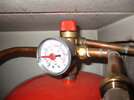The new braided coupler tubing from
Screwfix was successfully installed. Before doing this, I opened the water mains stopcock in the kitchen and confirmed a good flow from the flexible grey plastic mains water feed pipe. The EV was completely empty. It was removed, its air bladder pressurised via Schrader valve & Bike pump to 1.5 bar. The EV was then put back into its original position & the CH system was refilled, rads bled, and the EV water pressure raised to 1.2 bar, in under a minute, using the black valve knobs on the newly installed
Screwfix loop connector. It all went smoothly as I followed your instructions.
I also bled the pump of trapped air by using the screw valve on its fascia.
Unfortunately when the electrical power to the boiler was switched back on, the pump and boiler were on for 3 minutes and then shut off. Thinking that there was a problem with either the boiler's internal overheat thermostat or its Thermistor temperature sensor, I today bought new ones from Wolseley and put them in place of the old ones.
This made no difference to the situation. Its so FRUSTRATING!
Just to provide more detail, before I started work on the CH system, we had constant hotwater (always on) and heating for 3 hours in the mornings and 3 hours in the evenings. The HOT water was OK, reliably hot all the time but the CH was very temperamental, off more often than on during its 'ON' period.
Now both are off even with the programmer set to Always ON for both CH & HW. I've attached the Potterton Kingfisher MF manual to this post for any who are interested in it.



